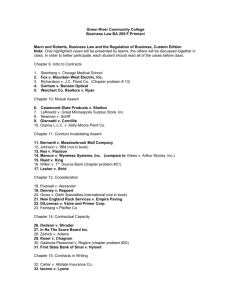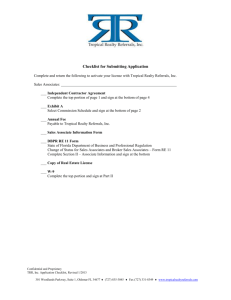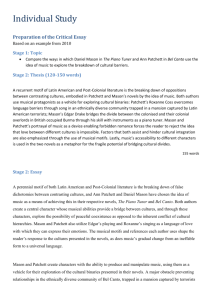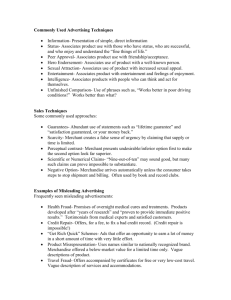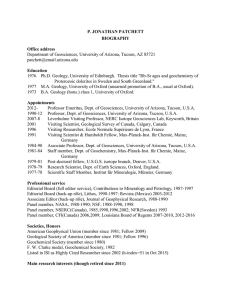ASD Keynote Speaker Powerpoint Presentation
advertisement
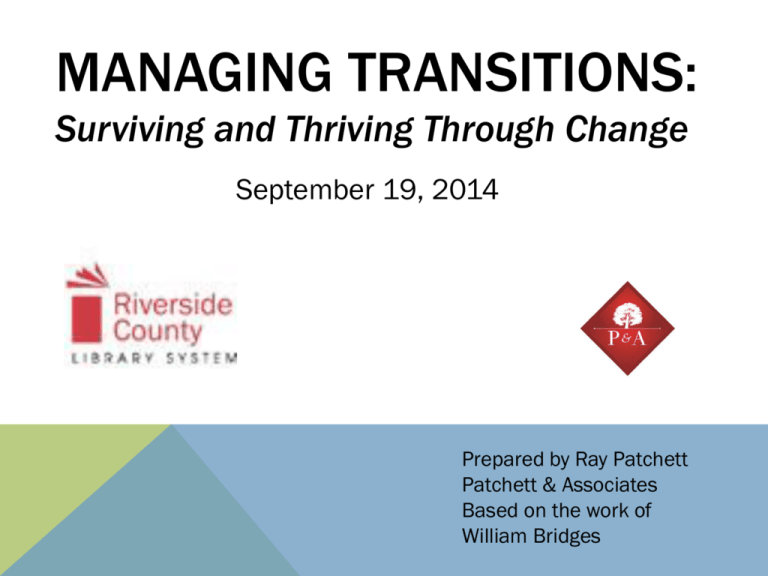
MANAGING TRANSITIONS: Surviving and Thriving Through Change September 19, 2014 Prepared by Ray Patchett Patchett & Associates Based on the work of William Bridges Managing Transitions: Surviving and Thriving Through Change Introduction/Overview/Key Concepts Endings/Letting Go The Neutral Zone/Adjusting New Beginnings/Clarifying and Following Through Conclusions and Implications © PATCHETT & ASSOCIATES LEARNING SERIES Introduction/Overview Context/Change Is Scary Change and Transition are Different Bill Bridge’s Transition Model Transitions: A Three Phase Process © PATCHETT & ASSOCIATES LEARNING SERIES Change Is SCARY! Many change efforts are a failure Change efforts are expensive Change efforts are risky Many change efforts succeed It’s the UNKNOWN © PATCHETT & ASSOCIATES LEARNING SERIES How Do You Feel When Managing Change? Share your story about managing CHANGE © PATCHETT & ASSOCIATES LEARNING SERIES Change & Transition Are Different C H A N G E I S S I T U AT I O N A L Reorganization of a team/organization Retirement of the leader Pension plan revisions Layoffs Budget cuts or funding Moving to a new facility TRANSITION IS PSYCHOLOGICAL A three-phase process to help people understand and successfully manage change: 1. Ending, Letting Go 2. The Neutral Zone 3. The New Beginning “It isn’t the changes that do you in, it’s the transitions.” © PATCHETT & ASSOCIATES LEARNING SERIES Bridge’s Transition Model © PATCHETT & ASSOCIATES LEARNING SERIES Managing Transitions: Helping People through the Three Phase Process 2. Neutral Zone 1. Ending, Letting Go 3. New Beginning © PATCHETT & ASSOCIATES LEARNING SERIES Group Exercise Individually Please identify and share a story where you experienced: Ending Neutral Zone New Beginning Identify a “key change” topic ???? © PATCHETT & ASSOCIATES LEARNING SERIES Endings/Letting Go Overview Defining/Clarifying Endings Guidelines to Help People Let Go Grieving's Five Stages Checklist to Manage Endings What I Can Do to Help © PATCHETT & ASSOCIATES LEARNING SERIES Defining and Clarifying Ending and Letting Go A concluding or terminating-when something comes to an end Cycle is complete Project is finished To conclude, consummate, finish, wind up or wrap up. © PATCHETT & ASSOCIATES LEARNING SERIES Endings/Letting Go Small Group Exercise Individually identify an “ending” you have experienced—work or personal– and answer the five questions: 1. Identify what is ending or came to an end? 2. What did you have to give up or let go? 3. Did you or someone else initiate it? 4. How did you feel? Who else was affected? 5. How effectively did you hand the letting go phase? When everyone has answered individually, share in the small/full group © PATCHETT & ASSOCIATES LEARNING SERIES Guidelines To Help People Let Go Listen empathetically—Don’t argue: Accept the reality of what is being said Don’t show surprise by overreacting Treat what is being said with respect Give people support, encouragement : Do It Again and Again Follow up after you meet or talk with them: Email, phone call, etc. © PATCHETT & ASSOCIATES LEARNING SERIES Guidelines To Help People Let Go Acknowledge the losses openly and sympathetically Compensate for the losses or endings: Help them through the process Mark the endings: Celebrations, events, parties, etc. Show how endings are a natural process no matter how difficult they may be to accept © PATCHETT & ASSOCIATES LEARNING SERIES Grieving: A Key Step In Letting Go Recognize the stages of Grieving (Elizabeth Kubler Ross, 1969) 1. 2. 3. 4. 5. Denial Anger Bargaining Depression Acceptance HOPE! © PATCHETT & ASSOCIATES LEARNING SERIES Managing Endings: A Checklist Have I: 1. Identified who is likely to lose what? 2. Provided people with accurate information? 3. Assessed the realities of the losses people will experience? 4. Recognized these losses with them? 5. Provided space for people to grieve? 6. Found ways to help people through the process? 7. Identified ways to mark the ending? © PATCHETT & ASSOCIATES LEARNING SERIES What suggestions can I/we make and what actions can I/we take to help people deal with the endings that are taking place? __________________________________________________________________________ __________________________________________________________________________ __________________________________________________________________________ __________________________________________________________________________ __________________________________________________________________________ __________________________________________________________________________ © PATCHETT & ASSOCIATES LEARNING SERIES The Neutral Zone Overview Defining and Clarifying the Neutral Zone Dangers Confusion Creative/Innovative Time Checklist to Manage the Neutral Zone What Can I Do to Help © PATCHETT & ASSOCIATES LEARNING SERIES Defining And Clarifying The Neutral Zone A nowhere between two somewheres You hang suspended between what was and what will be An in between time when the old is gone, but the new isn’t fully operational A very difficult time – everything is in FLUX © PATCHETT & ASSOCIATES LEARNING SERIES Neutral Zone Small Group Exercise 1. Identify what will be occurring 2. Clarify where/how uncertainty and confusion will most likely take place 3. Determine where there are likely opportunities for innovation and creativity to occur © PATCHETT & ASSOCIATES LEARNING SERIES Understanding Dangers In The Neutral Zone People’s anxiety rises and their motivation falls People feel disoriented and self-doubting Energy is drained from work into coping tactics Old weaknesses, previously patched over, reemerge Problems with communication and trust in leadership at all levels © PATCHETT & ASSOCIATES LEARNING SERIES Understanding Dangers In The Neutral Zone People are overloaded, frequently get mixed-signals and systems are in flux Priorities get confused, information is miscommunicated and tasks go undone Given the ambiguities it is easy for people to become polarized/disinterested in their work Teamwork is undermined, as is loyalty to the organization or previous leadership Worn down and tired, people often respond slowly and halfheartedly © PATCHETT & ASSOCIATES LEARNING SERIES The Neutral Zone Is Characterized By: Uncertainty Confusion Ambiguity © PATCHETT & ASSOCIATES LEARNING SERIES It is also a time for Innovation & Creativity A time more hospitable to new ideas Capitalize by encouraging people to be creative Do things differently Encourage experimentation © PATCHETT & ASSOCIATES LEARNING SERIES Managing The Neutral Zone: A Checklist Have I: 1. Done my best to explain that the neutral zone is an uncomfortable time? 2. Protected people adequately from inessential further changes? 3. Created temporary policies, roles, reporting relationships, and organizational groupings to get us through the neutral zone? 4. Set short-range goals, realistic output objectives and checkpoints? © PATCHETT & ASSOCIATES LEARNING SERIES Managing The Neutral Zone: A Checklist 5. Found ways to keep people feeling that they still belong to the organization and are a valued member of it? 6. Set up a Transition Monitoring Team? 7. Seen to it that people build their skills in creative thinking and innovation? 8. Found the special training programs we need to deal successfully with the neutral zone? © PATCHETT & ASSOCIATES LEARNING SERIES What suggestions can I/we make and what actions can I/we take to help people deal with the neutral zone? __________________________________________________________________________ __________________________________________________________________________ __________________________________________________________________________ __________________________________________________________________________ __________________________________________________________________________ __________________________________________________________________________ © PATCHETT & ASSOCIATES LEARNING SERIES New Beginnings Overview Defining and clarifying new beginnings A psychological phenomenon Get your house in order Checklists for new beginnings What can I do to help © PATCHETT & ASSOCIATES LEARNING SERIES Defining And Clarifying New Beginnings The act or process of bringing or being brought into existence The initial step in doing something New Beginnings involve: New understandings New values New Attitudes New identities Beginnings take place when people make an emotional commitment to do things the new way © PATCHETT & ASSOCIATES LEARNING SERIES Defining And Clarifying New Beginnings People discover the new sense of purpose and identity that make the change begin to work Experience a release of new energy in the new direction A psychological phenomena © PATCHETT & ASSOCIATES LEARNING SERIES Cultivate New Beginnings: Get Your House In Order Clarify your basic purpose Paint a picture/vision Provide clear strategic direction Lay out a step-by-step plan Engage people so they have an active part to play in the New Beginning © PATCHETT & ASSOCIATES LEARNING SERIES Managing The New Beginning: A Checklist Have I: 1. Accepted the fact that people are going to be ambivalent toward the beginning I am trying to bring about? 2. Taken care of the ending(s) and the neutral zone, or am I trying to make a new beginning happen before it possibly can? 3. Explained the Purpose, Picture, Plan and the Part people will play? © PATCHETT & ASSOCIATES LEARNING SERIES Managing The New Beginning: A Checklist 4. Checked to see that policies, procedures, and priorities are consistent with the new beginning? 5. Built into my plans some occasions for quick successes? 6. Found ways to celebrate the new beginning? 7. Found ways to symbolize the new identity— organizational and personal—that is emerging from this period of transition? © PATCHETT & ASSOCIATES LEARNING SERIES What suggestions can I/we make and what actions can I/we take to support the new beginning? __________________________________________________________________________ __________________________________________________________________________ __________________________________________________________________________ __________________________________________________________________________ __________________________________________________________________________ __________________________________________________________________________ © PATCHETT & ASSOCIATES LEARNING SERIES Conclusion And Implications Three major issues Communication Trust Accountability Actions within your power to take Transition Management as a Skill Reflections/Observations © PATCHETT & ASSOCIATES LEARNING SERIES Actions Within Your Power To Take: Communication Overcommunicate Actively listen to people Ask questions for clarification and to develop shared understanding Ask for feedback Don’t be surprised if your trust-building is viewed suspiciously © PATCHETT & ASSOCIATES LEARNING SERIES Actions Within Your Power To Take: Trust DWYSYWD Try extending trust of others a little further than you normally would Don’t confuse being “trustworthy” with “being a buddy” Be Your authentic self Don’t try to push others to trust you any further than you trust them © PATCHETT & ASSOCIATES LEARNING SERIES Actions Within Your Power To Take: Accountability Choose to be responsible Initiate action Keep commitments Understand what matters to people Tell the truth © PATCHETT & ASSOCIATES LEARNING SERIES Transition Management Is A Key Leadership Skill For Dealing With Change Use the concept of Ending, Neutral Zone and New Beginning as a framework to make managing transitions understandable. Leaders are in a constant state of transition and have to know how to manage themselves, their teams and organizations through the transition process. © PATCHETT & ASSOCIATES LEARNING SERIES Reflections & Observations What needs clarification/discussion? What takeaways or highlights stuck in your mind? What is most relevant to your situation? © PATCHETT & ASSOCIATES LEARNING SERIES Wisdom Source & Experience © PATCHETT & ASSOCIATES LEARNING SERIES

